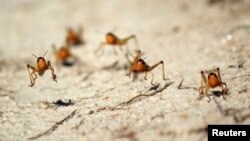Locust swarms filled the skies over Madagascar’s capital this week. However, an expert says it does not mean the locust plague in the nation has returned.
Annie Monard said the locust swarms over Antananarivo were caused by “exceptional weather” for the city -- high temperatures and winds blowing towards the capital. Usually, she said, the locusts won’t fly there because of the city’s altitude and lower temperatures.
Monard is in charge of the U.N. Food and Agriculture Organization’s locust campaign in Madagascar. She sounded the alarm years ago, warning of a plague if control measures were not conducted. They did not start on time due to a funding shortfall and a locust plague was officially declared. The nation’s crops were at risk.
“A large-scale control campaign started in September 2013 and the campaign has the duration mainly of the rainy season. A lot of operations were carried out during that time and they are still ongoing. And more than one-point-two million hectares were treated,” she said.
The first phase of the control campaign stopped the plague from growing worse. But more must be done to get the locust numbers down to pre-plague levels, known as a recession period. That’s when there are only scattered locust populations, which is normal for Madagascar.
“Now, it’s necessary to continue because we stopped the plague, but there are still locust populations in the southwestern part of Madagascar and in the western part of Madagascar. And it is necessary to continue controlling these locust populations and the remaining swarms to avoid the plague from starting again,” said Monard.
The FAO expert said two more large-scale locust campaigns are needed. However, funds are still being collected before the next program begins. She added that to be effective the second campaign should start very soon.
“The second campaign will start during the second half of September in order to have the teams in place in the field. The helicopter is planned to arrive in early October and the treatments start again with the rainy season, which should start in September/October as usual. [That’s] because the breeding of the locust populations starts with the rainy season.”
The FAO had warned that without locust control campaigns in Madagascar the livelihoods of 13-million people would be at risk.









